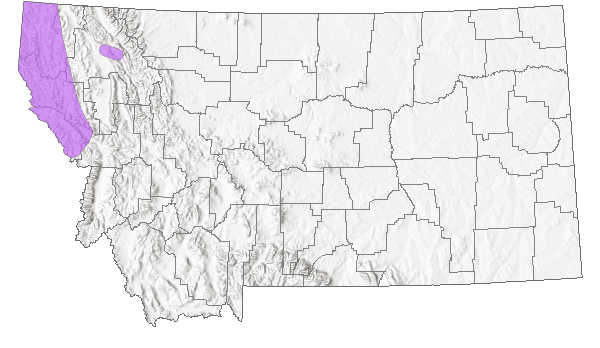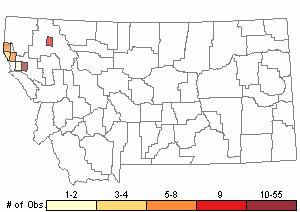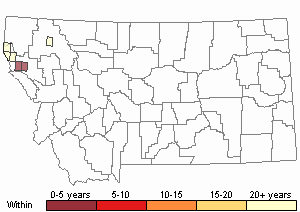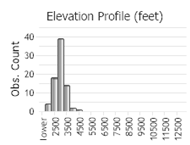View in other NatureServe Network Field Guides
NatureServe
Montana
Utah
Wyoming
Idaho
Wisconsin
British Columbia
South Carolina
Yukon
California
New York
Britton's Dry Rock Moss - Grimmia brittoniae
Other Names:
Britton's Black Rock Moss
General Description
Plant: Extremely hoary, compact glaucous blue-green cushions. Brown inside. Stems 2.0-3.0 cm tall.
Leaf: Dry leaves are loosely appressed to somewhat contorted. Moist leaf and stem make an angle of less than 25 degrees (erectopatent). Lanceolate, 0.5-1.0 x 0.3-0.4 mm, and keeled. Awn 2.0-4.0 long, smooth, flattened at base, and decurrent. Both margins narrowly recurved; however, once detached from the stem and placed under a coverslip the margins appear plain. Costa ends before apex, is weak, and projects on abaxial side (keeled).
Leaf Cells: Basal laminal cells near costa are rectangular, straight to little sinuose, and thick-walled. Basal laminal cells near margin are quadrate and thick-walled transversely. Median laminal cells are short-rectangular, little sinuose, and thick-walled. X-S: distal laminal and marginal cells are 1-layered. Costa X-S: smooth or angled (keeled) in outline. Stem X-S: Central strand absent.
Diagnostic Characteristics
The blue-green color when wet, cushions that crack into polygonal patterns when dry, extremely long awns, and the occurrence on vertical or rocky under hangings are distinct. It can be confused with G. funalis which is also found in hoary compact cushions, is glaucous-green in the upper portions, and brown within. However G. funalis has been separated as a distinct species and grows in Ontario, Canada, Louisiana and Michigan, USA, and in Eurasia. G. brittoniae is more closely related to G. orbicularis.
Species Range
Montana Range
Range Descriptions

 Native
Native
Range Comments
Endemic to northwestern Montana (Greven and Spribille 1999; Williams 1900) and immediately adjoining Idaho (Williams 1900). In Montana: Flathead, Lincoln, and Sanders Counties (Elliott 2016).
Observations in Montana Natural Heritage Program Database
Number of Observations: 88
(Click on the following maps and charts to see full sized version)
Map Help and Descriptions
Relative Density

Recency



 (Observations spanning multiple months or years are excluded from time charts)
(Observations spanning multiple months or years are excluded from time charts)
Habitat
Vertical faces of shaded, calcareous cliffs. Moderate elevations (1,640 – 2,300 feet). It grows in warm, dry but climatically moist valley bottoms or piedmont forests dominated by Douglas-fir.
Reproductive Characteristics
Dioicous. Seta is 2.0 mm tall, wavy, and symmetrically attached to base of capsule. Capsules are occasionally found, exserted, brown, ovoid, and wide-mouthed.
Gemmae absent on leaves.
Stewardship Responsibility
Threats or Limiting Factors
Road widening may threaten at least one population.
References
- Literature Cited AboveLegend:
 View Online Publication
View Online Publication Elliott, J.C. and A.K. Pipp. 2018. A Checklist of Montana Mosses (1880-2018). Updated 3 January, 2020. Montana Natural Heritage Program, Helena, Montana. 73 pp.
Elliott, J.C. and A.K. Pipp. 2018. A Checklist of Montana Mosses (1880-2018). Updated 3 January, 2020. Montana Natural Heritage Program, Helena, Montana. 73 pp. Greven, H., and T. Spribille. 1999. Grimmia brittoniae, a rare moss endemic to northwestern Montana. The Bryologist 102(1): 116-118.
Greven, H., and T. Spribille. 1999. Grimmia brittoniae, a rare moss endemic to northwestern Montana. The Bryologist 102(1): 116-118. Williams, R.S. 1900. Two new species of Grimmia from Montana. Bulletin of the Torrey Botanical Club 27:316-319.
Williams, R.S. 1900. Two new species of Grimmia from Montana. Bulletin of the Torrey Botanical Club 27:316-319.
- Additional ReferencesLegend:
 View Online Publication
View Online Publication
Do you know of a citation we're missing? Elliot, J. C. 1993. Second checklist of Montana mosses. Unpublished report. U.S. Forest Service, Region 1. Missoula, MT. 45 pp.
Elliot, J. C. 1993. Second checklist of Montana mosses. Unpublished report. U.S. Forest Service, Region 1. Missoula, MT. 45 pp. Flora of North America Editorial Committee, eds. 2007. Flora of North America North of Mexico. Volume 27. Bryophytes: Mosses, Part 1. Oxford University Press, Inc., NY. xxi + 713 pp.
Flora of North America Editorial Committee, eds. 2007. Flora of North America North of Mexico. Volume 27. Bryophytes: Mosses, Part 1. Oxford University Press, Inc., NY. xxi + 713 pp. Lawton, E. 1971. Keys for the Identification of the Mosses on the Pacific Northwest. Reprinted from 'Moss Flora of the Pacific Northwest'. Published as Supplement No. 2 of the Journal of the Hattori Botanical Laboratory. Nichinan, Miyazaki, Japan. 66 pp.
Lawton, E. 1971. Keys for the Identification of the Mosses on the Pacific Northwest. Reprinted from 'Moss Flora of the Pacific Northwest'. Published as Supplement No. 2 of the Journal of the Hattori Botanical Laboratory. Nichinan, Miyazaki, Japan. 66 pp. Lawton, E. 1971. Moss Flora of the Pacific Northwest. Hattori Botanical Laboratory. Japan: Yamabuki-cho, Shinjuku-ku, Tokyo. 362 pages plus appendices.
Lawton, E. 1971. Moss Flora of the Pacific Northwest. Hattori Botanical Laboratory. Japan: Yamabuki-cho, Shinjuku-ku, Tokyo. 362 pages plus appendices.
- Web Search Engines for Articles on "Britton's Dry Rock Moss"





